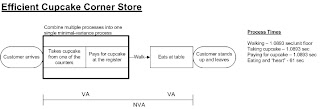The standard Cupcake Corner process flow can be shown as follows:
Note that this standard process applies to all regular players. However, note that we can group some of the processes into a single process, and thus eliminating/minimizing walking altogether. For example, this is my proposed solution to this problem.
EFFICIENT! :)
So what happened here? Simple, I combined two processes together, and eliminated the need to walk. The updated value-stream map can be seen here:
The only time that customers do need to walk is after they paid for a cupcake, and before they start eating at their table. Using this efficient system, the flow can be summarized below:
- At 100% satisfaction, customers arrive at a weibull distribution Weibull(Alpha = 6.83, Beta = 7.35, Gamma = 0)
- Combined process of taking and paying for cupcake takes a total of 2.875 seconds
- Walking to table takes 1.15 seconds/unit floor
- Eating takes a total of 61 seconds
- Total process time ~ 69.49 seconds, or a total of 91% utilization
- Expected number of customers (using Little's Law) is between 8 to 12 people at any given time, so optimally you should always have at most 12-14 tables in the store to minimize walking distance

In conclusion, this report shows the optimal Cupcake Corner system, as well as the minimum number of chairs you should keep in the store at any given time.
Conclusion:
12-14 chairs max
Place counter and register such that customer don't have to walk between these two processes.


